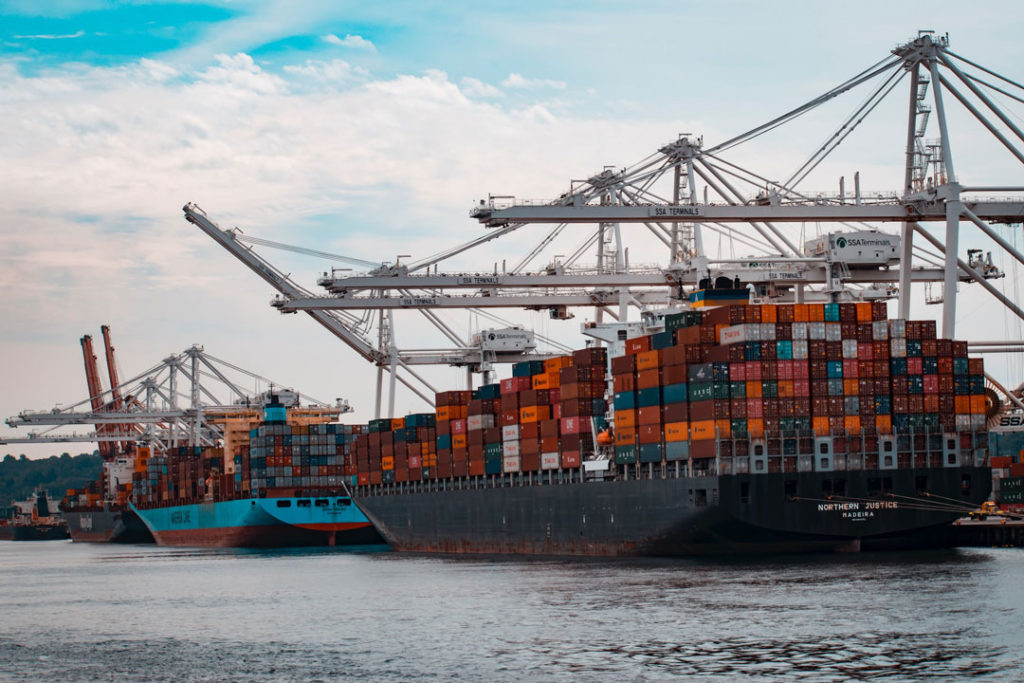
International freight transportation infrastructures require careful planning and continuous optimization. Due to their intertwined nature, problems anywhere in the supply chain can cause serious problems for brands.
Whether it’s delayed shipments or expensive quotations that you’re looking to avoid, seeking professional advice is probably the best option.
Or you could just read on below and see how Nic Smith, Izba’s international freight network handler, advises brands to consider setting up their international freight infrastructure.
How Should Brands Reduce International Freight Costs?
Offering insights from his experience handling Transpacific Eastbound and Indian Subcontinent (TPEB-ISC) trade, Nic says that to understand Ocean freight costs, you need to understand the recent history of rates.
For most supply chain managers, it’s possible that they might just be realizing the substantial drop in rates since the market peaks in late 2020, or early 2021.
When COVID-19 first became an issue, we had mass shutdowns of factories, and logistics came to a standstill. It was not until a few months into 2020 that everyone started seeing Ocean rates begin to increase.
This was a result of the reopening of factories and the eCommerce boom. As demand soared, so did the rates. We reached a peak of about $25k in some routings from Asia to the US, in some cases, even higher.
This was caused by ocean carriers such as MSC, ONE, Hapag Lloyd, and CMA implementing Premium Pricing for brands to guarantee their shipment is first loaded onto vessels at the origin.
Over the past 3-6 months, we have witnessed drastic reductions in rates. Current day rates to the West Coast are about $2,500 and to the East Coast are $3,500.
We are witnessing the rates ease back to a normal market level. The cause of this reduction is directly tied to the spike in imports earlier this year and reduced consumer spending.
Many brands are already sitting on all the required inventory, or are overstocked as they forecasted higher than anticipated sales for holiday 2022. This, in return, drops the demand for Ocean freight as there is no longer the demand we saw prior.
Ocean carriers, for years, have implemented blank sailings, which are an attempt to artificially increase demand and reduce the supply (of ocean containers) in ports by having ports skipped by the vessels during some sailings.
Though this has worked in the past in some cases, it has yet to stop the drop in rates we have seen over the past few months.
On the brand’s side, one could anticipate cutting forecasted ocean freight spending substantially when compared to 2020 and 2021.
How Can You Control International Freight Pricing?
Nic advises starting off with understanding how quotes work from ocean carriers and from freight forwarders.
An ocean carrier such as MSC and freight forwarder will create an agreement around March of each year allocating space for both Fixed rates and Market rates (also referred to as FAK).
These contracts are set up with MQCs (Minimum Quantity Commitment) that the forwarder agrees to meet. From there, when a brand receives a quote, it is typically lower than what is sold from a carrier directly as it utilizes the forwarder’s volume discount.
FAK rates are the typical market rates a brand will see when they do not have a fixed contact setup. These rates are only valid for a 15-day period for TPEB-ISC and a 30-day period for other trade lanes.
The best action a brand can take to ensure they’re being priced accurately is to always have your forwarder provide updated rates on the 1st and 15th of every month.
Your shipments will be charged to the freight forwarder from the ocean carrier based on the rate of the day the shipment ingates for TPEB-ISC trade or the sailing date for other trade lanes.
For example, if your shipment ingates in Yantian on the 16th of the month, but your rates were only covering the 1st-15th of the month, you could be missing out on the rate reductions made the day prior if you do not request your forwarder to requote the shipment.
You are able to always go back to your forwarder and request to have a shipment requoted based on the actual ingate date.
On the flip side, forwarders will always reach out to you if your shipment ingates on the 16th and there’s a GRI (General Rate Increase) to ensure they receive their correct profit on the shipment.
Minimizing International Freight Costs Via Routing
Talking about the timing of the quotes, Nic explains a way that you can work with different routing options to minimize cost.
The trick is that brands should always consider 2-3 routing options when looking to move a shipment. Typically, they should evaluate more when they are moving to a rail ramp so they cover all their options.
As an example, if a brand is moving to Chicago, they should be requesting options via Canada West Coast (WC) ports, US WC ports and US East Coast (EC) ports to have a healthy comparison of transit times and rates to make an educated decision.
The US West Coast will be the most efficient, but with the highest costs.
The second would be via Canada WC with slightly cheaper rates and higher transit times, and the third will be via EC where you will see the highest transit time but typically the lowest costs.
For anything east of Chicago, Nic recommends utilizing EC routings and for west of Chicago, using a WC option would be best.
An important point to keep in mind when moving via rail is the current chassis issues faced at ramps.
With the influx of inventory over the past several months, warehouse space has dwindled in many key locations. This has caused more importers to hold their containers on chassis as they wait for space to open up.
In effect, chassis shortages can be found in many inland rail locations such as Chicago. With the reduced chassis availability, we see more charges of demurrage and rail storage fees occur as truckers cannot obtain a chassis to recover the container.
Reducing International Freight Costs Through Shipment Configurations
In response to a client’s query about when and how to negotiate with manufacturers and carriers, it is great to have these open conversations with your suppliers and your warehouses.
There are two options to load an FCL (Full Container Load).
First, you floor load the container, meaning the supplier will fully stuff the container with raw cartons/cargo.
The second option is to have your supplier palletize the cargo, typically you can fit about 40 pallets (stackable) in a 40’ container or 20 pallets (stackable) in a 20’ container.
First, from the supplier side, you need to understand the utilization of space. If you are floor loading, you will always be able to have more cargo in the container versus palletizing the freight.
There will be additional charges from your supplier in most cases here.
On the warehouse side, they will always prefer palletized cargo over floor-loaded cargo, as it takes more man-hours to break down the container and potentially will have to hold the container for a longer period. You will see reduced receiving costs on palletized goods.
Once these charges are understood, you can then look at your container space utilization based on the volume of goods in a floor-loaded unit compared to a palletized unit. You should be able to identify from here what is more valuable for you.
On an additional note, I recommend trying to consolidate your LCL shipments as much as possible. If you are shipping 6 pallets or more, you will typically see an FCL 20’ be a cheaper option than moving via LCL.
If you have multiple POs coming from suppliers near each other, you can also request your forwarder or agent to consolidate the shipments together at a CFS (Container Freight Station) location to create an FCL shipment.
International Freights and Peak Periods

A major concern most brands face is the higher shipment costs encountered during the holiday season.
In a normal market, you will see peak seasons occur in the Summer and in the Holiday seasons when there is an influx of demand for containers around the world.
There is also typically a spike in rates prior to Chinese New Year (CNY) when Chinese factories usually close for 3-4 weeks.
But we are not in a normal market. With the drop in demand, the typical Q3-Q4 peak is gone and we have seen rates actually drop drastically.
With the decrease in demand and rates falling, there is little risk or rush for brands to worry about CNY rate spikes, during the pre-and post-holiday season.
How Many Forwarders Should a Brand Have in Its Portfolio?
Nic says, “My recommendation is to always have 2-3 strong forwarders you trust and have a good standing relationship with.”
This allows you to obtain diverse pricing and services and provides the ability to negotiate your volume. In the market you are entering, forwarders will be open to negotiations and pricing comparisons to obtain business.
It is healthy to have open discussions about your forecast and provide feedback on rates whether they won the bid or not.
Additionally, having these options will provide you with leeway to get out of potentially sticky situations such as issues with bookings, trucking or customs.
You are always able to shift a shipment to another forwarder if it has arrived at the port and your current forwarder is having issues obtaining a driver.
Spot and Fixed-Based Market System in International Freight
“To give some definition on the two rate options, spot rates are the live market rates updated bi-weekly or monthly by the ocean carrier, while fixed rates are an agreement on an MQC and routing between an importer and either a freight forwarder or carrier.”
Nic says that some brands want to have fixed rates, but knowing the right time to present your proposition to a carrier may determine whether or not you get it.
So, when should a brand provide that information to the forwarders? Nic says, “When a rate is fixed, you will typically have a single ocean carrier covering your shipments, and the rate is divided by the container tariff rate and the bunker rate (oil).”
The tariff rate will stay the same over the 12-month contract, and the bunker rate will typically float based on the market and should be updated every quarter.
Fixed rates protect you from the changing Spot Market rates and lock in your anticipated freight spend, but there will be points (Peak) where the Spot Market is cheaper than the Fixed rates.
Last year, rates spiked, resulting in the worst possible time to sign a fixed contract, but coming into the 2023 contract season, we see some great options to sign while the rates are falling to a certain extent.
Typically for a fixed rate deal, depending on your forwarder, you will need to guarantee 400-500 TEU (equivalent to 400-500 20’ or 200-250 40’) on a routing.
This volume must be split evenly between weeks. In some cases, you could obtain what is called a basket rate, which could cover a handful of routings, but it is recommended to discuss this further with your forwarder during negotiations.
One point to drive home here is to not sign any agreement that will monetarily penalize you for not performing to the agreement. We saw this occur in contracts in 2021-2022.
Additionally, do not agree to 100% of your total volume on a contract. Only obtain fixed rates for 50%-75% of your total volume so you can freely move shipments into the Spot Market if it drops below the fixed rate you have agreed to.”
Reducing Air Freight Shipment Costs
The air freight market has responded differently though. While the rates have dropped since the peak of 2020-2021, it has not been as drastic of a reduction compared to Ocean. Currently, you can see air rates range from $6 – $9/kg.
The value in air is always the speed of the transport, typically 7-10 days door to door. Nic’s recommendation for importers is to always try to move via ocean when possible.
Usually, for izba’s clients, if air is needed, we recommend moving enough units to cover demand and move the remaining units via Ocean. This requires a detailed forecast but can result in hefty savings when it comes to their overall freight costs.
How to Reduce International Freight Custom Costs?
When importing goods from most countries into the US, you will face import duties, customs clearance charges and a handful of additional fees.
For importers that have shipments on a monthly basis, it is best that you set up a Continuous Customs Bond with your customs agent.
This is a legal agreement between you, your customs agent and US Customs that you will comply with the US regulations and immediately pay your customs fees upon the goods arriving in the US.
This will allow your shipments to be processed quickly on the customs side and remove the costs of creating single customs bond entries, typically $100-$200 per shipment.
There is a cost to the continuous bond, the importer will need to pre-pay a small percentage of their anticipated duties upfront.
Additionally, an importer can create an account with customs to pay their duties upfront, without a customs broker or forwarder charging disbursement charges.
This is typically 0.3-0.4% of the total duties due upon import. You are able to set this up alongside your continuous bond to obtain the best savings on your customs imports.

Nic Smith
Operations Consultant At izba
Nic Smith started his freight career at Kuehne + Nagel which is one of the top 3PLs in the world. His job there was handling Transpacific Eastbound and Indian sub-continent (TPEB-ISC) trade which is Asia and India to the US.
Nic says, “I worked between sales reps and trade-in pricing and allocation positions. My role on a day-to-day basis was managing shipments, building out strategies to help clients, obtaining space from ocean carriers and negotiating rates with brands.”
“I really had a full overview of how these markets work when it comes down to an ocean rate side and was kind of, you know, a bad guy when it comes down to the brand’s side. I was the one deciding on exactly what factors played into the rates, at the end of the day.”
“It was a very interesting time to understand the entire ocean freight market, where we saw the normal market back in 2019 and then the heavy spike of 2020 and 2021 where you saw rates basically go from $2,000 to $25,000 in a very short period.”
“With that, I’d gained a very good understanding of exactly how to cut costs on freight and manage relationships with freight forwarders.“
Nic is helping brands have a better understanding of international freight costs and where he can help work around these ever-changing markets when it comes to freight.
Want professional help from expert consultants like Nic Smith? Call Izba and we’ll help you sort through your problems!





2 thoughts on “Understanding International Freight with Nic Smith”
Pingback: Freight Rates: Pre-COVID and Post-COVID Differences - izba
Pingback: Navigating Ocean Freight: Insights from Nic Smith - izba